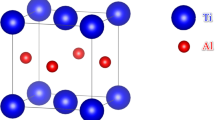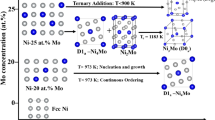Abstract
The temporal evolution feature of a microscopic phase field model is utilized to study the antisite defects of L12-Ni3Al; this is quite different from other physicist’ interests. There are mainly two points in brief. Firstly, antisite defects NiAl and AlNi, which are caused by the deviation from the stoichiometric Ni3Al, coexist in the Ni3Al phase. The surplus Ni atom in the Ni-rich side is prone to substitute Al thus producing the antisite defect NiAl that maintains the stability of the L12 structure. In other case, the surplus Al atom in the Al-rich side is accommodated by a Ni sublattice consequently giving rise to antisite defect AlNi. The calculated equilibrium occupancy probability of NiAl is much higher than that of AlNi. This point is generally in line with other theoretical and experimental works. Additionally, both NiAl and AlNi have a strong negative correlation to time step during the disorder-order transformation. Since the initial value of NiAl and AlNi on each site of the matrix is right at the concentration that we set, we can observe the decrease process of NiAl and AlNi from the initial disordered high anti-structure state to their respective equilibrium state, i.e. to the result of the ordering process further coarsening.
Similar content being viewed by others
References
Ruban A V, Skriver H L. Calculated site substitution in ternary γ‖IH-Ni3Al: Temperature and composition effects. Phys Rev B, 1997, 55: 856–874
Oramus P, Massobrio C, Kozłowski M, et al. Ordering kinetics in Ni3Al by molecular dynamics. Comput Mater Sci, 2003, 27: 86–190
Peng P, Soh A K, Yang R, et al. First-principles study of alloying effect of Re on properties of Ni/Ni3Al interface. Comput Mater Sci, 2006, 38: 354–361
Mekhrabov A O, Akdeniz M V, Arer M M. Atomic ordering characteristics of Ni3Al intermetallics with substitutional ternary additions. Acta Mater, 1997, 45: 1077–1083
Gao F, Wang T M, Calder A F, et al. Defect production and atomic mixing by displacement cascades in Ni3Al. Sci China Ser E-Technol Sci, 1997, 40: 553–560
Foiles S M, Daw M. S. Application of the embedded atom method to Ni3Al. J Mater Res, 1987, 2: 5–15
Mishin Y. Atomistic modeling of the γ and γ′ phases of the Ni-Al alloys. Acta Mater, 2004, 52: 1451–1467
Fu C L, Painter G S. Point defects and the binding energies of boron near defect sites in Ni3Al: A first-principles investigation. Acta Mater, 1997, 45: 481–488
Schweiger H, Semenova O, Wolf W, et al. Energetics of point defect formation in Ni3Al. Scr Mater, 2002, 46: 37–41
Badura-Gergen K, Schaefer H E. Thermal formation of atomic vacancies in Ni3Al. Phys Rev B, 1997, 56: 3032–3037
Würschum R, Badura-Gergen K, Kümmerle E A, et al. Characterization of radiation-induced lattice vacancies in intermetallic compounds by means of positron-lifetime studies. Phys Rev B, 1996, 54: 849–856
Nic J P, Mikkola D E. Site occupancy in ternary L12 ordered alloys as determined by diffraction: Observations on (Al,Cr)3Ti alloys. Intermetallics, 1999, 7: 39–47
Ikeda T, Almazouzi A, Numakura H, et al. Single-phase interdiffusion in Ni3Al. Acta Mater, 1998, 46: 5369–5376
Krachler R, Semenova O P, Ipser H A. statistical-thermodynamic model for intermetallic phases with L12-structure and its application to the compound Ni3Al. Phys Status Solidi B-Basic Solid State Phys, 1999, 216: 943–954
Xie Z Y, Diana F. Atomistic structure and lattice effects of vacancies in Ni-Al intermetallics. J Mater Res, 1994, 9: 875–883
Wang Y Z, Li J. Phase field modeling of defects and deformation. Acta Mater, 2010, 58: 1212–1235
Haataja M, Muller J, Rutenberg A D, et al. Dislocations and morphological instabilities: Continuum modeling of misfitting heteroepitaxial films. Phys Rev B, 2002, 65: 165414
Shen C, Wang Y. Phase field model of dislocation networks. Acta Mater, 2003, 51: 2595–2610
Shen C, Wang Y. Incorporation of γ-surface to phase field model of dislocations: Simulating dislocation dissociation in fcc crystals. Acta Mater, 2004, 52: 683–691
Karma A, Lobkovsky A E. Unsteady crack motion and branching in a phase-field model of brittle fracture. Phys Rev Lett, 2004, 92: 245510
Henry H, Levine H. Dynamic instabilities of fracture under biaxial strain using a phase field model. Phys Rev Lett, 2004, 93:105504
Hakim V, Karma A. Crack path prediction in anisotropic brittle materials. Phys Rev Lett, 2005, 95: 235501
Spatschek R, Muller-Krumbhaar H, Brener E, et al. Phase field modeling of fracture and stress-induced phase transitions. Phys Rev Lett, 2007, 75: 066111
Mahadevan M, Bradley R M. Simulations and theory of electromigration-induced slit formation in unpassivated single-crystal metal lines. Phys Rev B, 1999, 59: 11037
Bhate D N, Kumar A, Bower A F. Diffuse interface model for electromigration and stress voiding. J Appl Phys, 2000, 87: 1712–1721
Yu H C, Lu W. Dynamics of the self-assembly of nanovoids and nanobubbles in solids. Acta Mater, 2005, 53: 1799–1807
Lu G, Zhang Q, Kioussis N, et al. Hydrogen-enhanced local plasticity in aluminum: An ab initio study. Phys Rev Lett, 2001, 87: 095501
Hennig R G, Trinkle D R, Bouchet J, et al. Impurities block the α to w martensitic transformation in titanium. Nat Mater, 2005, 4: 129–133
Johnson R A, Brown J R. Vacancies and antisite defects in ordered alloys. J Mater Res, 1992, 7: 3213–3218
Mishin Y. Embedded-atom potential for B2-NiAl. Phys Rev B, 2002, 65: 224114
Song Y, Guo Z X, Yang R, et al. First principles study of site substitution of ternary elements in NiAl. Acta Mater, 2001, 49: 1647–1654
Liu J B, Johnson D D, Smirnov A V. Predicting yield-stress anomalies in L12 alloys: Ni3Ge-Fe3Ge pseudo-binaries. Acta Mater, 2005, 53: 3601–3612
Meyer B, Fähnle M. Atomic defects in the ordered compound B2-NiAl: A combination of ab initio electron theory and statistical mechanics. Phys Rev B, 1999, 59: 6072–6082
Gururajan M P, Abinandanan T A. Mean field theory of point defects in β-NiAl. Intermetallics, 2000, 8: 759–767
Fähnle M, Mayer J, Meyer B. Theory of atomic defects and diffusion in ordered compounds and application to B2-FeAl. Intermetallics, 1999, 7: 315–323
Khachaturyan A G. Theory of Structural Transformations in Solids. New York: Willey, 1983. 19
Chen L Q. Phase-field models for microstructure evolution. Annu Rev Mater Res, 2002, 32: 113–140
Poduri R, Chen L Q. Computer simulation of morphological evolution and coarsening kinetics of δ′(Al3Li) precipitates in Al-Li alloys. Acta Mater, 1998, 46: 3915–3928
Poduri R, Chen L Q. Computer simulation of atomic ordering and Compositional clustering in the pseudobinary Ni3Al-Ni3V alloys. Acta Mater, 1998, 46: 1719–1729
Li Y S, Chen Z, Lu Y L, et al. Coarsening kinetics intermetallic precipitates in Ni75AlxV25−x alloys. J Mater Res, 2007, 22: 61–67
Hu Q M, Yang R, Hao Y L, et al. Concentrated point defects in and order-disorder transition temperature of intermetallic compounds. Phys Rev Lett, 2004, 92: 185505
Chen L Q, Simmons J A. Microscopic master equation approach to diffusional transformations in inhomogeneous systems—single site approximation and direct exchange mechanism. Acta Metal Mater, 1994, 42: 2943–2954
Author information
Authors and Affiliations
Corresponding author
Rights and permissions
About this article
Cite this article
Zhang, J., Chen, Z., Lu, Y. et al. Microscopic phase field study of the antisite defect of Ni3Al in binary Ni-Al alloys. Sci. China Phys. Mech. Astron. 53, 2047–2053 (2010). https://doi.org/10.1007/s11433-010-4121-z
Received:
Accepted:
Published:
Issue Date:
DOI: https://doi.org/10.1007/s11433-010-4121-z




